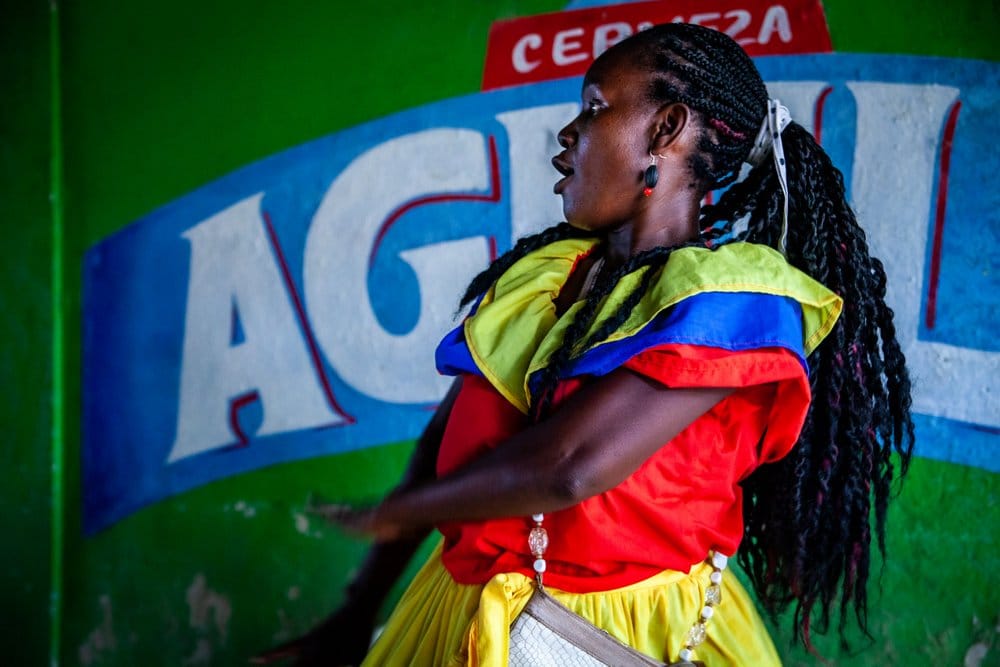7 Colombian dances to experience local culture
Music and dancing are central to Colombian culture. Whether it is at a party in the city or a local festival, we celebrate by coming together to enjoy different rhythms. These are the 7 traditional Colombian dances you will want to see during your stay.
1. Cumbia
Cumbia is a musical genre present in many Latin American countries. Colombian cumbia was born out of the cultural interaction between local indigenous people, Afro-descendant communities, and Spanish colonizers on the northern coast. It evokes a courtship ritual where men move freely to go after women. In return, they glide with short steps making their hips go up and down to the beat of drums and flutes.
The Cumbia attire is one of the most recognizable in the context of Colombian dances. Women wear checkered white and red off-the-shoulder blouses with long, wide skirts. Men wear white shirts and pants, topped with the traditional sombrero vueltiao.

2. Bullerengue
This dance is tied to Colombia’s Caribbean Afro-descendants. Oral tradition suggests it hails from western African rites regarding a girl’s coming of age, as well as maternity.
This is one of the Colombian dances that used to be exclusive to women, since they were not allowed to engage with music in the presence of men in their settlements. Over time, it became festive, and men joined in.
The bullerengue rhythm consists of drums and the voice of a woman who acts as a cultural and spiritual guide to her community. The dance is similar to cumbia. Performers wear colorful clothes, although classical versions call for all-white attire. Men sport shirts and pants, while women wear tops and long skirts.
3. Joropo
This rhythm is typical in Colombia’s eastern plains, where it represents a man’s bravery to command his environment. In the dance, men hold and lead women.
Its main move is the zapateo or quick stomping. Joropo allegedly finds its roots in Spanish flamenco.
Dancers wear colorful clothing and traditional footwear. Men sport matching long-sleeved shirts and pants. Women wear tight tops and short, puffy skirts.
4. Bambuco
Practiced all over the Andean regions of Colombia, it came to life as a mix of Spanish and indigenous traditions. The dance resembles a waltz, in which the couple comes in contact only briefly and delicately.
In bambuco, men wear a hat, a white shirt, dark pants, and a red bandana around their neck. Women dress in blouses and long skirts. These can be brightly colored, or white with multicolored flowers or embroidery.
5. Torbellino
Torbellino is also from Colombia’s Andes region. In this dance, couples perform a courtship ritual, dancing around each other with small, quick steps. They also call to each other in verse, deepening the cheeky nature of torbellino.
The dance attires reflect the traditional peasant style. Men wear white long-sleeved shirts, dark pants, farmer hats, and poncho-like garments called ruana.
Women sport white long-sleeved shirts with ribbons and lace, along with dark, long skirts. They also wear hats and shawls.
6. Mapalé
Returning to Caribbean Colombian dances, mapalé is another Afro-descendant rhythm. Performers dance vigorously to drums and other percussion instruments. Some say the moves represent sex, while others argue they emulate the violent reactions of slaves to their masters’ whips. Some believe mapalé is the name of a fish that flips fiercely to return to the water when captured.
In mapalé, men wear only pants, while women pair short tops with short skirts. All clothing is colorful.
7. Modern Colombian dances
Nowadays, many Colombian dances are arising. They take inspiration from their predecessors and combine their influences. Prominent examples include:
- Champeta: Also from the Caribbean Coast, champeta is an heir to West African beats. It mixes traditional percussion instruments with the sounds of synthesizers, basses, and electric guitars. When dancing by themselves, people perform upbeat moves with their feet. Couples only hold each other tightly and sway their hips to the music.
- Salsa choke: This urban combination of African, salsa, and reggaeton rhythms originated on the Pacific Coast. It gained popularity during the 2014 FIFA World Cup, where Colombia’s soccer team danced salsa choke on the field and inside their dressing room to celebrate their accomplishments.
Dive into Colombian music and culture
Our diverse influences have made their mark on Colombian culture. Accordingly, Colombian dances and musical genres form a tapestry that showcases our indigenous, African, and Spanish heritage. Be sure to admire some of them during your stay.
Discover your ideal itinerary for free!
At Lulo Colombia Travel, we create amazing travel itineraries that are tailor-made to your travel style and preferences.
Let us help you come up with an ideal route for your trip in Colombia. By answering the following short questions we will provide you on the spot with a free and personalized itinerary that will serve as a starting point for an unforgettable journey!
Discover your ideal itinerary for free!
At Lulo Colombia Travel, we create amazing travel itineraries that are tailor-made to your travel style and preferences.
Let us help you come up with an ideal route for your trip in Colombia. By answering the following short questions we will provide you on the spot with a free and personalized itinerary that will serve as a starting point for an unforgettable journey!
